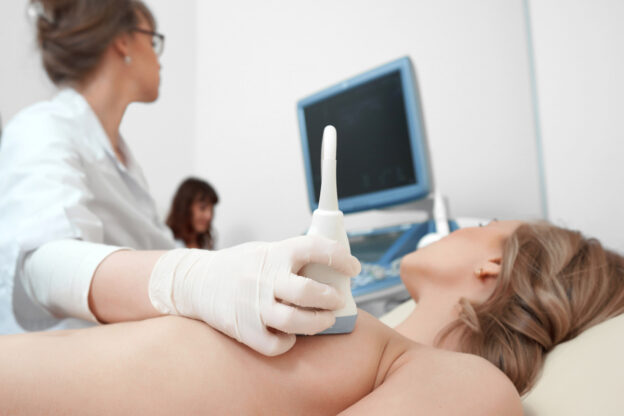Breast Implant Placement: Under-the-muscle vs. Over-the-muscle

The decision about your breast implant placement, whether over or under the chest muscle, will have a noticeable effect on your breast augmentation outcome. Your plastic surgeon will help you make this (and other) key choices in your consultation, and to help you prepare, Board-Certified Plastic Surgeon Dr. Emily Kirby is sharing the pros and cons of over-the-muscle versus under-the-muscle implant placement.
Under-the-muscle (submuscular) breast implant placement
With under-the-muscle, or submuscular, implant placement, the upper portion of your breast implant is placed below the pectoralis major chest muscle. This allows your implant to be cushioned by muscle tissue and glandular breast tissue. This extra coverage can give you a more natural-looking result if you have small natural breasts, creating a softer, more seamless transition from the décolleté to the upper pole.
Compared with subglandular placement, subpectoral placement may be less likely to interfere with breastfeeding. Further, placement of implants under the muscle is associated with a lower risk of capsular contracture, a breast augmentation complication in which scar tissue abnormally thickens and constricts around the implant.
It is important to remember, however, that submuscular implants take more time to recover and for final results to be visible. While you will enjoy fuller, shapelier breasts immediately after the bandages come off, it will take several months before breast implants settle behind the muscle; this is known as the “dropping and fluffing” process.
The dropping and fluffing process after under-the-muscle placement
Immediately following surgery, implants placed under-the-muscle will appear firm and sit higher on the chest due to chest muscle tightness. This is completely normal! When placed under the muscle, new implants create outward pressure on your chest muscle, and the muscle tightens in response, leading to a temporarily firm, high appearance. In what is known as the “drop and fluff” process, the chest muscles gradually relax, allowing your implant to drop lower on the chest and fluff out beneath the muscle, filling out the lower portion of the breast for a fuller appearance and more natural breast shape.
Immediately following surgery, implants placed under-the-muscle will appear firm and sit higher on the chest due to chest muscle tightness.
The timeline for the drop-and-fluff process is different for each individual, and it is normal for one implant to drop faster than the other, often related to which hand is dominant. Patients with very fit, developed pectoralis muscles, such as runners, find the process takes a bit longer than average. While this process requires some patience, my Fort Worth breast augmentation patients find that the wait is well worth it.
- Still choosing a surgeon? Here are 5 things to look for in their before & after galleries »
Over-the-muscle (subglandular) breast implant placement
With over-the-muscle, subglandular or subfascial, breast implant placement, breast implants are positioned below the glandular and fatty tissue of your breasts, and above the pectoralis muscles. Subfascial augmentation places implants below the breast tissue and fascia layer overlying the pectoralis muscles. In other words, your existing breast tissue will cover the implant. This creates a natural-looking result for women with adequate natural breast tissue.
Implants “settle in” more quickly with subglandular and subfascial placement. Your results will be visible after the bulk of swelling has subsided within a few weeks. (Minor swelling will continue to subside, but will not significantly change your breasts’ appearance.) Compared with submuscular placement, recovery tends to be somewhat quicker since pectoral muscles do not need time to relax. This placement may also accommodate larger breast implant volumes than submuscular placement.
Compared with submuscular placement, over-the-muscle recovery tends to be somewhat quicker since pectoral muscles do not need time to relax.
Another potential benefit of subglandular and subfascial placement is that there is no risk of breast animation deformity, which refers to visible movement of under-the-muscle implants when flexing the pectoralis muscles. Animation deformity may be more common for athletic women with very little body fat and for those who are undergoing breast reconstruction surgery with implants.
However, if you choose saline-filled breast implants placed over the muscle, you will be more likely to experience visible rippling. This occurs especially when there is not enough coverage from breast tissues (usually in thin women).
How to choose your ideal breast implant placement
In the hands of experienced board-certified plastic surgeons, both breast implant placement options have an extensive track record of success. But each has certain advantages that may be important in your case. Talk with a plastic surgeon who is board certified and has extensive breast surgery experience to learn which placement will be best-suited for your goals, lifestyle, and anatomy.
Schedule your breast augmentation consultation with board certified plastic surgeon Dr. Emily Kirby
At Kirby Plastic Surgery in Fort Worth, female Board-Certified Plastic Surgeon Dr. Emily Kirby offers a full range of cosmetic plastic surgery for the breast and body, including tummy tuck, liposuction, and mommy makeover. A Castle Connolly Top Doctor, Dr. Kirby has over 10 years of experience with breast augmentation in private practice and is dedicated to empowering you on your plastic surgery journey. To schedule your personal consultation and learn about your breast augmentation options, call or text 817-292-4200 or reach out to us online today.


